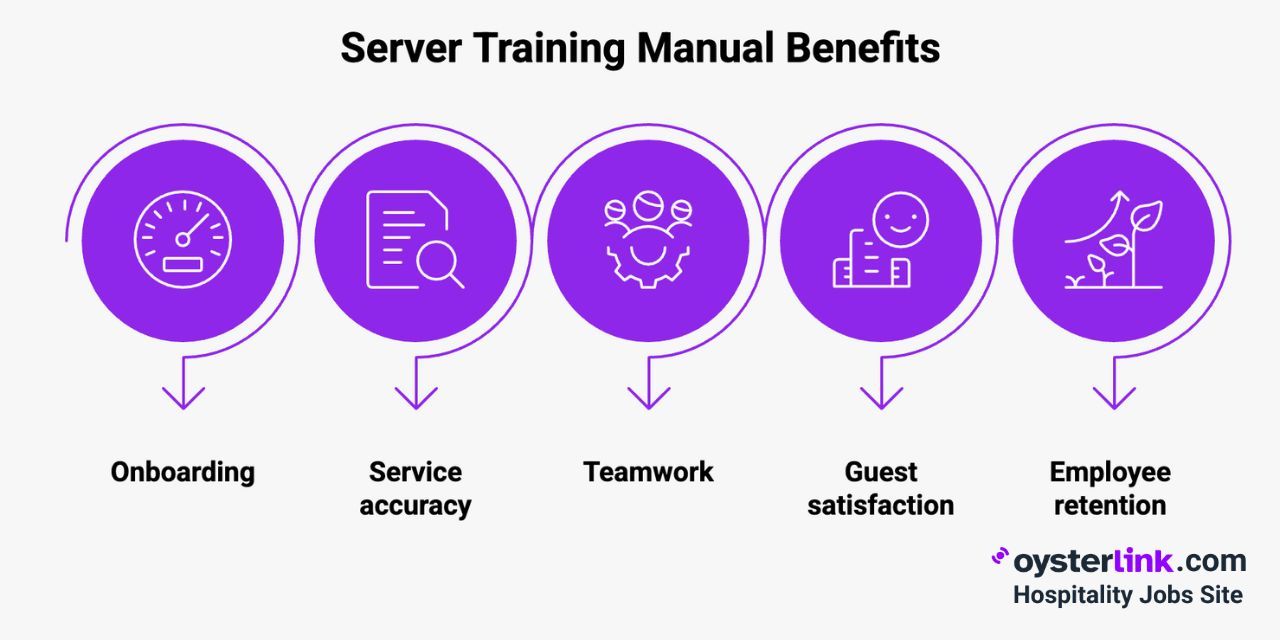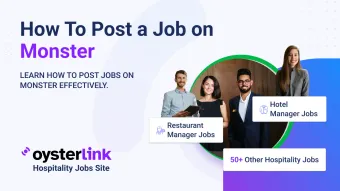Server Training Manual Key Takeaways:
- Structured training improves consistency and guest satisfaction.
- A clear manual speeds up onboarding and sets expectations.
- POS training, menu knowledge and service standards build confidence and reduce errors.
- Regularly updated, tailored manuals boost retention and team performance.
Training Restaurant Servers goes beyond memorizing menu items or carrying trays. The best-performing restaurants invest in structured onboarding that sets expectations, builds consistency and fosters professionalism from day one.
Whether you’re a new restaurant preparing for your first staff hire or an established business improving team performance, this Server training manual template will help you create a clear, efficient and repeatable training process.
Why You Need a Server Training Manual
A server training manual ensures consistency in how your staff is trained. It also improves the customer experience by making sure every Server is equipped to handle orders, resolve issues and represent your brand with professionalism.
Key benefits include:
- Faster, smoother onboarding
- Fewer mistakes during service
- Better team coordination
- Higher guest satisfaction
- Improved retention through clearer expectations

Let’s break down the key components of an effective server training manual.
Restaurant Server Training Manual Template
Use this outline to build or revise your manual. Each section is designed to be practical, editable and easy to tailor to your restaurant’s concept.
1. Introduction
This section introduces the purpose and tone of the manual. It sets the stage for new Servers, providing a warm welcome and helping them understand what to expect during training and beyond.
Purpose of the manual:
Explain why this manual exists and how it will be used. Make it clear that it's a guide to ensure consistent service and growth for both new and current servers.
Example:
Welcome to the [Restaurant Name] team! This manual is your go-to resource for understanding how to provide excellent service, meet expectations and contribute to a smooth, enjoyable dining experience. Use it during training and refer back to it whenever needed.
2. Company Overview
This part explains the restaurant’s brand, values and style of service. It helps Servers understand the restaurant’s identity and their role in upholding it.
- Mission & values: Share what makes your restaurant unique. Highlight your vision for hospitality and how servers help deliver it.
- Restaurant concept: Briefly describe your cuisine, service style and clientele.
- Dress code & grooming standards: Include clear guidelines for uniforms, shoes, hygiene, accessories and general appearance.
3. Job Expectations
Outlines what Servers are responsible for on a daily basis. This section includes a clear breakdown of duties, behaviors and shift requirements.
- Server responsibilities: Create a bulleted list of core duties and shift expectations.
Example:
- Greet guests within 60 seconds of seating
- Take orders accurately and promptly
- Serve food and beverages with attention to timing and presentation
- Pre-bus and maintain a clean dining area
- Handle guest concerns with professionalism
- Upsell specials or promotions when appropriate
- Collaborate with Hosts, Bussers and kitchen staff
- Arrive 15 minutes early
- Clock in/out procedures
- End-of-shift side work
4. Guest Service Standards
Details how Servers should interact with guests to deliver a consistent and high-quality dining experience. This includes communication, order handling and complaint resolution.
Greeting & seating:
Scripts and tone guidelines for first impressions.
Order taking:
- How to use the POS system
- Tips for remembering orders
- What to ask when someone orders a steak or allergy-prone dish
Serving protocols:
- Food delivery order (serve women first? serve clockwise?)
- Beverage refills
- Pre-bussing etiquette
Handling complaints: Use the L.A.S.T. method (Listen, Apologize, Solve, Thank).
Upselling tips: Train Servers to mention high-margin or seasonal items naturally.
5. Menu Knowledge
Covers what Servers need to know about the food and drinks being served. Understanding ingredients, allergens and pairings is essential for making informed recommendations.
Food menu:
Servers should know:
- Ingredients of popular dishes
- Common allergens
- Portion sizes
- Recommended pairings
Drink menu:
- Wine varietals and pairing suggestions
- Signature cocktails
- Non-alcoholic options
Quizzes & tastings: Encourage managers to test staff with flashcards or tasting days.
6. Health & Safety Guidelines
Provides guidance on maintaining a safe and sanitary environment. It includes food handling, allergy awareness and emergency protocols.
Food safety:
- Handwashing protocol
- Cross-contamination prevention
- Temperature guidelines (for hot/cold food)
Allergy awareness:
- How to flag and communicate food allergies
- What to do if a guest has a reaction
Emergency procedures:
- What to do in case of fire, power outage or injury
- Who to contact and where emergency exits are
7. Point-of-Sale (POS) Training
Introduces the POS system used in the restaurant. This section explains how to take orders, process payments and troubleshoot basic issues.
System walkthrough:
Include screenshots or demo steps for:
- Logging in
- Taking an order
- Splitting checks
- Comping items
- Printing receipts
Common errors: List troubleshooting tips for frequent mistakes.
8. Side Work & Closing Duties
Lists the behind-the-scenes tasks servers are expected to complete before, during and after their shifts. Proper side work keeps the restaurant running smoothly.
Break it down by shift: opening, mid-shift and closing.
Examples:
- Rolling silverware
- Restocking condiments
- Refilling ice bins
- Sweeping floors
- Cleaning menus or tabletops
Assign zones or rotate responsibilities to avoid burnout or confusion.
9. Team Communication
Describes how Servers should communicate with coworkers and managers. Effective communication ensures smooth shift transitions and guest satisfaction.
- Shift handover procedures: How to pass off a table or communicate guest needs when shifts change.
- Using the Server logbook: What to document (complaints, unavailable items, VIP guests).
- Language & tone expectations: Keep language professional, respectful and guest-friendly at all times — even during busy shifts.
10. Performance Expectations
Outlines how Server performance will be monitored and evaluated. This section encourages continuous improvement through feedback and training milestones.
Evaluations:
- When evaluations occur (e.g., 30/60/90 days)
- Metrics: speed of service, guest feedback, teamwork, accuracy
Progress tracking: Have a simple checklist for each milestone in training.
Ongoing development: Encourage participation in wine tastings, menu development or cross-training.
11. Policies & Procedures
Clarifies the restaurant’s rules regarding attendance, conduct and compensation. This ensures accountability and fairness across the team.
Attendance policy: How to request time off, what to do if running late or sick.
No-show/Call-out consequences: Clarify how missed shifts affect performance or employment status.
Harassment & discrimination policy: Outline behavior expectations and reporting procedures.
Tipping policy:
- Tip pooling vs. individual tips
- Credit card tip payout timeline
12. On-the-Floor Training Schedule
Provides a day-by-day breakdown of the training timeline. It helps new hires know what they’ll be doing and when they’re expected to be fully independent.
Day 1: Orientation
- Meet the team
- Restaurant tour
- Uniform fitting
Days 2–5: Shadowing
- Follow experienced servers
- Focus on observing flow, POS use, guest service
Days 6–7: Assisted service
- Trainee takes orders with trainer supervision
Days 8–10: Solo service with observation
- Trainee runs a section while manager or trainer observes and gives feedback
13. Training Checklist
A practical tool to track progress during training. It shows which tasks and skills have been completed and who approved them.
Include a printable or digital checklist to track completed items.
Task | Completed (Y/N) | Trainer Initials | Date |
| Watched orientation video | Y | AB | 6/1 |
| Completed POS tutorial | Y | CD | 6/2 |
| Passed menu quiz | Y | EF | 6/4 |
Use this as a sign-off tool before granting full floor responsibilities.
14. Restaurant Terms Glossary
Defines common industry terms and slang. This helps new Servers understand team lingo and communicate more effectively.
Include a short glossary for front-of-house language and slang.
Examples:
- 86’d: An item is no longer available
- In the weeds: Server is overwhelmed
- On the fly: Urgent request
- Campers: Guests who linger long after the meal
- Turn a table: Serve and seat a new party in the same spot
15. Final Notes & Signature Page
Wraps up the manual with motivational remarks and a signature line. It confirms the Server has read and understands the contents.
Wrap up the manual with encouragement and expectations.
Example:
As a Server, you represent the heart of the guest experience. We’re here to help you succeed and grow with us. Ask questions, stay curious, and take pride in delivering great service.
Include a final sign-off section confirming the server read and understood the manual.
Tips for Using This Restaurant Server Training Guide
This section helps managers and trainers get the most out of the manual. These tips ensure that your training process stays relevant, engaging and effective as your restaurant evolves.
- Customize for your restaurant type: Casual diners, fine-dining bistros and fast-paced brunch spots all have different service demands. Adjust terminology, flow and menu complexity accordingly.
- Pair it with real-time training: Manuals are reference tools, not replacements for shadowing or real-world exposure.
- Keep it updated: Revise the manual quarterly or seasonally to reflect new menus, procedures, or policies.
- Use clear language: Avoid industry jargon unless you define it. Break information into bulleted lists and visual checklists to help servers retain key points.
Final Thoughts on Server Training Guides
A Server training manual is more than just a set of instructions — it’s a foundational tool that shapes the guest experience, staff culture and daily operations. When created with care, it can streamline onboarding, reduce costly mistakes and build a stronger, more confident team.
Don’t treat your manual as a one-time project. Keep it alive by updating it regularly, integrating team feedback and using it as both a training and coaching resource. A well-used manual supports a consistent, high-performing team that elevates your restaurant’s service and reputation.









Loading comments...